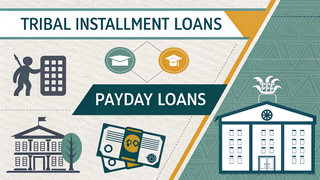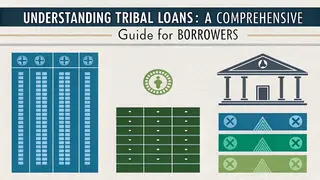Table of Contents
- Introduction
- Current Landscape of Tribal Lending
- Technological Innovation in Tribal Lending
- Regulatory Evolution and Compliance
- Financial Inclusion and Access
- Product Diversification and Innovation
- Enhanced Customer Experience
- Tribal Economic Development
- Strategic Partnerships and Collaborations
- Challenges and Opportunities
- Conclusion
Introduction
The tribal lending industry has emerged as a significant component of the alternative financial services marketplace over the past decade. As Native American tribes exercise their sovereign status to establish online lending operations, this sector continues to evolve in response to technological advancements, regulatory developments, and changing consumer needs. This article explores the future trajectory of tribal lending, examining emerging trends and potential developments that may shape this unique financial niche in the coming years.
From the integration of cutting-edge financial technology to navigating complex regulatory landscapes, tribal lenders are at a pivotal moment of transformation. Understanding these trends is essential not only for industry participants but also for consumers seeking to make informed decisions about their financial options in a rapidly changing marketplace.
Current Landscape of Tribal Lending
Before examining future trends, it's important to understand the current state of tribal lending:
- Economic foundation: Tribal lending enterprises have become significant revenue sources for many Native American communities, providing funding for essential tribal government services, healthcare, education, and infrastructure development.
- Digital presence: The majority of tribal lending operations function primarily online, offering borrowers across the country access to installment loans through web-based platforms.
- Market positioning: Tribal lenders typically focus on serving consumers with limited access to traditional banking services or those with credit challenges who may not qualify for conventional loans.
- Regulatory framework: Tribal lenders operate under the sovereign immunity of their tribes, though they interact with a complex web of federal regulations, state laws, and industry standards.
- Industry organization: Many tribal lenders have joined industry associations such as the Native American Financial Services Association (NAFSA), which promotes responsible lending practices and advocates for tribal sovereign rights.
As the industry matures, tribal lending is poised for significant transformation in various aspects of its operations, products, and market approach.
Technological Innovation in Tribal Lending
Technology is rapidly reshaping the tribal lending landscape, with several key innovations likely to gain prominence:
Advanced Underwriting Algorithms
Tribal lenders are increasingly adopting sophisticated AI-driven underwriting models that look beyond traditional credit scores. These systems incorporate alternative data points such as banking history, utility payments, and rental information to better assess borrower risk. This technological evolution enables more accurate risk evaluation while potentially expanding access to credit for qualified borrowers who may have limited traditional credit histories.
Blockchain and Smart Contracts
The integration of blockchain technology and smart contracts represents a potential game-changer for tribal lending operations. These technologies can:
- Enhance transparency: Creating immutable records of loan terms and transactions
- Reduce operational costs: Automating many aspects of loan origination and servicing
- Improve security: Providing robust protection for sensitive borrower information
- Streamline compliance: Creating automated systems for regulatory adherence
Mobile-First Platforms
As mobile device usage continues to dominate internet access, tribal lenders are developing sophisticated mobile applications and responsive platforms that enable:
- Seamless application processes: Allowing borrowers to complete the entire loan journey from their smartphones
- Enhanced account management: Providing intuitive tools for payment scheduling and loan monitoring
- Integrated financial education: Offering resources and tools to improve borrowers' financial literacy
Open Banking Integration
The adoption of open banking technologies is enabling tribal lenders to access customer banking data securely and efficiently (with customer permission). This integration streamlines the verification process, reduces fraud, and enables more accurate affordability assessments. As open banking standards continue to evolve in the United States, tribal lenders that effectively leverage these technologies will gain competitive advantages through improved efficiency and customer experience.
Regulatory Evolution and Compliance
The regulatory landscape for tribal lending continues to evolve, with several key trends emerging:
Clearer Jurisdictional Frameworks
Recent court decisions and ongoing legal developments are gradually clarifying the boundaries between tribal sovereignty and state regulatory authority. The future likely holds more definitive legal frameworks that recognize legitimate tribal lending operations while establishing clear parameters for consumer protection. This evolution may include:
- Formal recognition of tribal regulatory bodies
- Established protocols for coordination between tribal and state authorities
- Clearer standards for determining legitimate tribal involvement in lending operations
Enhanced Compliance Technology
Tribal lenders are increasingly investing in sophisticated "RegTech" solutions that automate and streamline compliance processes. These technologies help lenders navigate the complex regulatory landscape while reducing operational costs and risks. Future developments may include:
- AI-powered compliance monitoring that adapts to changing regulations
- Automated reporting systems that ensure timely and accurate regulatory submissions
- Real-time risk assessment tools that identify potential compliance issues before they become problems
Self-Regulation and Industry Standards
Industry associations like NAFSA are likely to expand their self-regulatory frameworks, establishing robust standards for responsible lending, transparency, and consumer protection. These efforts help tribal lenders demonstrate their commitment to ethical practices while potentially mitigating external regulatory pressures. Future self-regulatory initiatives may include:
- Enhanced certification programs for tribal lenders
- Industry-wide monitoring mechanisms to ensure adherence to best practices
- Standardized disclosure formats that improve transparency and consumer understanding
Financial Inclusion and Access
Tribal lending has historically served consumers who face barriers to mainstream financial services. This focus on financial inclusion is likely to expand in several ways:
Serving the Underbanked
Approximately 22% of American adults are either unbanked or underbanked, with limited access to traditional financial services. Tribal lenders are positioned to serve this significant market segment through:
- Tailored products designed for consumers with limited credit histories
- Alternative qualification methods that look beyond conventional credit metrics
- Educational resources that help borrowers navigate financial decisions
Credit Building Initiatives
More tribal lenders are likely to implement programs designed specifically to help borrowers build or rebuild their credit profiles:
- Expanded credit bureau reporting to ensure on-time payments positively impact borrowers' credit scores
- Graduated loan programs that reward successful repayment with improved terms on subsequent loans
- Credit monitoring tools that help borrowers track their progress toward better financial health
Financial Education Resources
Forward-thinking tribal lenders recognize that long-term success involves helping customers improve their financial situations. Expect to see expanded educational initiatives including:
- Interactive financial literacy platforms integrated into lender websites and apps
- Personalized financial coaching offered as a complementary service
- Budget planning tools to help customers manage their finances effectively
Product Diversification and Innovation
While installment loans have been the primary offering of most tribal lenders, the future will likely bring significant product diversification:
Expanded Loan Products
Tribal lenders are beginning to expand beyond short-term installment loans to offer a broader range of credit products designed to meet diverse consumer needs:
- Longer-term installment loans with lower interest rates for qualified borrowers
- Specialized financing options for specific purposes such as education, home improvement, or healthcare expenses
- Secured loan options that offer better rates by allowing borrowers to provide collateral
Credit Line Products
Revolving credit lines represent a natural evolution for tribal lenders looking to establish ongoing relationships with customers:
- Flexible credit lines that allow customers to borrow only what they need, when they need it
- Tiered credit systems that offer improved terms as customers demonstrate responsible usage
- Virtual credit card integration for convenient access to approved credit
Banking-Adjacent Services
Some tribal entities may explore offering broader financial services beyond lending:
- Prepaid card products that provide banking-like functionality for the underbanked
- Money transfer services targeting communities with limited access to traditional banking
- Bill payment platforms that simplify financial management for customers
Small Business Financing
Some tribal lenders may expand into small business lending, particularly targeting underserved entrepreneurs who face barriers with traditional business financing:
- Microloans for small business startup costs
- Working capital solutions for established small businesses
- Equipment financing options with flexible terms
Enhanced Customer Experience
As competition in the alternative lending space intensifies, tribal lenders will increasingly differentiate themselves through superior customer experience:
Streamlined Application Processes
The future of tribal lending will feature increasingly frictionless application experiences, with technology playing a central role:
- One-click applications that leverage secure data sharing to pre-fill information
- Real-time verification systems that dramatically reduce waiting periods
- Automated document processing using advanced OCR and AI technologies
Personalized Customer Journeys
Data analytics and AI will enable tribal lenders to create highly personalized experiences for each customer:
- Customized loan offerings based on individual financial profiles and needs
- Personalized repayment schedules that align with the borrower's income patterns
- Tailored communication that adapts to customer preferences and behaviors
Omnichannel Support
Future tribal lending platforms will offer seamless customer service across multiple channels:
- AI-powered chatbots providing instant responses to common questions
- Video chat options for more complex customer service interactions
- Integrated messaging systems that maintain conversation history across channels
- Self-service portals that empower customers to manage their accounts independently
Transparent Terms and Communication
Leading tribal lenders will differentiate themselves through exceptional transparency, helping borrowers fully understand their financial commitments:
- Interactive loan calculators that clearly demonstrate total costs and payment schedules
- Plain-language disclosures that go beyond regulatory requirements
- Proactive communication about upcoming payments and account status
Tribal Economic Development
The evolution of tribal lending will continue to have significant implications for tribal economic development:
Revenue Diversification
Many tribes are using lending revenue as a foundation to diversify their economic activities, creating more sustainable and resilient tribal economies:
- Investment in additional business ventures beyond financial services
- Development of tribal infrastructure that supports multiple economic initiatives
- Creation of investment funds to support long-term growth and sustainability
Job Creation and Workforce Development
As tribal lending operations mature and expand, they create significant employment opportunities:
- High-quality job creation in technology, finance, customer service, and compliance roles
- Skills development programs that train tribal members for careers in financial services
- Remote work opportunities that allow tribal members to remain within their communities
Community Development Initiatives
Tribal lending revenues are increasingly being channeled into comprehensive community development programs:
- Educational scholarships and grants for tribal members
- Healthcare infrastructure and services improvements
- Cultural preservation projects that strengthen tribal identity and heritage
- Housing development and homeownership assistance programs
Strategic Partnerships and Collaborations
The future of tribal lending will likely involve increased collaboration with various entities in the financial ecosystem:
Fintech Partnerships
Strategic alliances between tribal lenders and financial technology companies will accelerate technological adoption and innovation:
- Technology licensing agreements that provide access to cutting-edge platforms
- Joint development initiatives for new financial products and services
- Data sharing partnerships that enhance risk assessment capabilities
Inter-Tribal Collaborations
Increased cooperation among tribal lenders may lead to significant economies of scale and shared resources:
- Shared technology platforms that reduce development and maintenance costs
- Unified compliance frameworks that streamline regulatory adherence
- Collaborative advocacy efforts to protect tribal sovereign rights in the financial sector
Educational Institutions
Partnerships with colleges, universities, and vocational schools will help develop the specialized workforce needed for this evolving industry:
- Specialized curriculum development for financial services careers
- Internship and apprenticeship programs that provide hands-on experience
- Research partnerships that advance understanding of alternative financial services
Traditional Financial Institutions
Some tribal lenders may develop relationships with traditional banks that can provide complementary services:
- Credit referral networks that connect consumers with appropriate financial products
- Banking services integration that expands the range of available financial solutions
- Transition pathways that help consumers move from alternative to traditional financial services
Challenges and Opportunities
The future of tribal lending presents both significant challenges and promising opportunities:
Ongoing Regulatory Complexity
Navigating the evolving regulatory landscape will remain a primary challenge for tribal lenders:
- Continuing legal challenges regarding jurisdictional boundaries
- Evolving federal regulations affecting all financial service providers
- State-by-state regulatory variations that complicate nationwide operations
Market Competition
The alternative lending space continues to attract new entrants and innovations:
- Increased competition from fintech startups and established financial institutions
- Pressure on interest rates and fees as options expand for consumers
- Rising consumer expectations for seamless digital experiences
Technology Investment Requirements
Keeping pace with technological advancements requires significant ongoing investment:
- Continuous platform upgrades to maintain competitive functionality
- Cybersecurity enhancements to protect sensitive customer data
- AI and data analytics capabilities to improve underwriting and customer experience
Expansion Opportunities
Despite these challenges, several promising opportunities lie ahead:
- Serving the persistent gap in financial services for underbanked consumers
- Product diversification beyond traditional installment loans
- International expansion to serve similar market segments in other countries
- Building recognizable brands known for responsible lending practices
Conclusion
The future of tribal lending is at an exciting crossroads, characterized by technological innovation, evolving regulatory frameworks, and expanding opportunities for financial inclusion. As tribal lenders continue to adapt and innovate, they are positioned to play an increasingly important role in the broader financial services ecosystem while providing critical economic development for tribal communities.
Success in this evolving landscape will require tribal lenders to embrace technological advancement, maintain an unwavering commitment to regulatory compliance, and continue developing products that effectively serve the needs of their target consumers. Those that can navigate these challenges while leveraging their unique sovereign status will find substantial opportunities for sustainable growth and positive impact.
For consumers, the evolution of tribal lending means more options, improved experiences, and potentially better terms as competition and technology drive innovation. However, as with any financial decision, consumers should continue to carefully evaluate their options, understand the terms of any loan product, and borrow responsibly based on their specific financial circumstances.
The path forward for tribal lending will undoubtedly include both challenges and opportunities, but the industry's demonstrated resilience and adaptability suggest a future of continued growth and development as an important component of the American financial services landscape.




